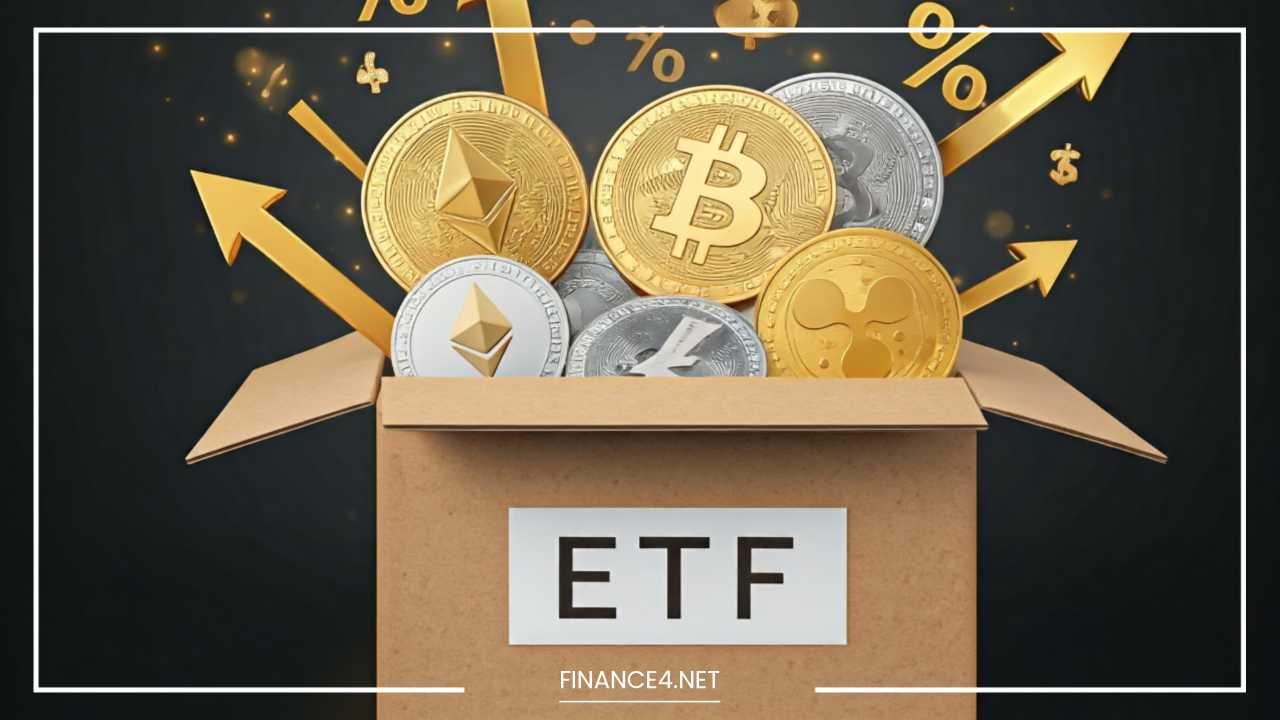How Do Cryptocurrency Exchange-Traded Funds (ETFs) Work?

Cryptocurrency Exchange-Traded Funds
Understanding Cryptocurrency ETFs: How They Work and What to Know
Cryptocurrency Exchange-Traded Funds (ETFs) have emerged as a groundbreaking development in the investment world, offering a regulated and accessible avenue for investors to gain exposure to cryptocurrencies.
These financial products have bridged the gap between traditional finance and the digital asset space, providing a way to invest in cryptocurrencies without the complexities associated with direct ownership.
This comprehensive guide will explore the inner workings of cryptocurrency ETFs, their various types, benefits, risks, and broader implications for both investors and the financial markets.
Understanding ETFs
Exchange-Traded Funds (ETFs) are investment funds traded on stock exchanges, similar to individual stocks. They offer a way to invest in a diversified portfolio of assets without needing to buy each asset individually.
ETFs are designed to track the performance of a specific index, sector, commodity, or asset class. Here’s a deeper dive into their core characteristics:
Key Characteristics of ETFs
- Trading Flexibility: ETFs can be bought and sold throughout the trading day at market prices. This provides investors with the flexibility to enter or exit positions based on real-time market conditions, unlike mutual funds that only trade at the end of the trading day.
- Transparency: ETFs are required to regularly disclose their holdings, performance, and other critical information. This transparency allows investors to understand the composition of the ETF and assess its performance.
- Cost Efficiency: ETFs typically have lower expense ratios compared to actively managed mutual funds. This is because many ETFs are passively managed, meaning they aim to replicate the performance of a specific index rather than actively selecting securities.
- Diversification: By pooling investors’ capital, ETFs can invest in a broad range of assets. This diversification helps spread risk and can reduce the impact of individual asset volatility on the overall portfolio.
How Cryptocurrency ETFs Work
Cryptocurrency ETFs are designed to provide investors with exposure to cryptocurrencies through a structured financial product. Here’s a detailed look at how these ETFs operate:
1. Issuance and Structure
- Creation of the ETF: Financial institutions, typically asset management firms, create cryptocurrency ETFs by developing a fund strategy and filing a prospectus with relevant securities regulators (e.g., the U.S. Securities and Exchange Commission, or SEC). This prospectus details the ETF’s investment objectives, strategy, underlying assets, risks, and fees.
- Approval and Listing: After the prospectus is approved by regulators, the ETF is listed on a stock exchange. This process involves meeting regulatory requirements and exchange-specific criteria, ensuring that the ETF adheres to necessary standards for trading.
2. Investment Mechanics
- Purchasing ETF Shares: Investors buy shares of the cryptocurrency ETF through brokerage accounts, similar to how they would purchase other stocks or ETFs. Each share represents a fractional ownership in the ETF’s underlying assets or derivatives.
- Investment in Derivatives: The ETF’s manager uses the pooled funds to invest in cryptocurrency derivatives such as futures contracts, options, and swaps. These derivatives derive their value from the price of underlying cryptocurrencies, allowing the ETF to gain exposure to price movements without holding the actual digital assets.
3. Tracking and Performance
- Objective of Tracking: The primary goal of a cryptocurrency ETF is to track the performance of its underlying assets or derivatives as closely as possible. The ETF’s share price should reflect changes in the value of these assets, providing investors with a way to benefit from cryptocurrency price movements.
- Tracking Error: There may be discrepancies between the ETF’s performance and that of the underlying assets, known as tracking error. Factors contributing to tracking error include management fees, derivative pricing discrepancies, and market liquidity issues. ETF managers strive to minimize tracking error to ensure accurate tracking of the underlying assets.
4. Trading and Liquidity
- Market Access: ETF shares are traded on stock exchanges, providing investors with the ability to buy and sell shares throughout the trading day. This offers greater liquidity and flexibility compared to trading individual cryptocurrencies, which may be subject to limited trading hours and varying liquidity.
- Real-Time Pricing: Unlike direct cryptocurrency investments, where prices can be volatile and may not reflect real-time market conditions, ETFs provide real-time pricing based on supply and demand in the stock market. This allows investors to execute trades at current market prices.
Types of Cryptocurrency ETFs
Cryptocurrency ETFs come in various forms, each offering different methods of exposure to the cryptocurrency market. Here’s an in-depth look at the main types of cryptocurrency ETFs:
1. Physically-Backed ETFs
- Direct Ownership of Cryptocurrencies: These ETFs hold actual cryptocurrencies like Bitcoin or Ethereum. By investing in these ETFs, investors gain direct exposure to the price movements of these digital assets.
- Custody and Security: Managing and securing physical cryptocurrencies involves significant challenges. ETFs that hold actual cryptocurrencies must employ robust custody solutions to ensure the safe storage of digital assets. This often involves using specialized storage facilities and security measures to protect against theft or loss.
2. Futures-Based ETFs
- Futures Contracts: Futures-based ETFs invest in futures contracts tied to cryptocurrency prices. Futures are financial agreements to buy or sell an asset at a predetermined price on a specified future date. These contracts allow the ETF to gain exposure to the anticipated future price movements of cryptocurrencies.
- Contango and Backwardation: Futures-based ETFs may encounter market conditions such as contango (where futures prices are higher than the spot price) or backwardation (where futures prices are lower). These conditions can impact the ETF’s performance relative to the actual cryptocurrency prices. Managing these factors is crucial for the ETF’s performance.
3. Thematic ETFs
- Focused Investment Themes: Thematic ETFs target specific areas or trends within the cryptocurrency space. These can include sectors like blockchain technology, decentralized finance (DeFi), or privacy-focused cryptocurrencies. Thematic ETFs provide targeted exposure to particular segments of the market, allowing investors to capitalize on specific trends or innovations.
- Sector-Specific Exposure: By focusing on particular themes or technologies, thematic ETFs enable investors to invest in niches within the broader cryptocurrency ecosystem. This specialized approach can attract investors interested in specific aspects of the cryptocurrency market.
Benefits of Investing in Cryptocurrency ETFs
Cryptocurrency ETFs offer several advantages, making them an appealing option for investors seeking exposure to digital assets. Here’s a detailed examination of the benefits:
1. Diversification
- Portfolio Expansion: Cryptocurrency ETFs provide a way to diversify investment portfolios by adding exposure to the cryptocurrency market. This diversification can reduce reliance on traditional asset classes like equities and bonds and potentially enhance overall returns.
- Variety of Assets: Depending on the ETF, investors may gain exposure to a range of cryptocurrencies or related financial instruments. This broad exposure contributes to a diversified investment strategy within the cryptocurrency sector.
2. Regulation and Transparency
- Regulatory Oversight: ETFs are subject to regulation by securities authorities, which helps ensure adherence to trading standards and investor protection. This regulatory framework provides a level of safety and transparency compared to the often less regulated cryptocurrency exchanges.
- Disclosure Requirements: ETFs must regularly disclose their holdings, performance, and other critical information. This transparency allows investors to assess the fund’s operations, strategies, and performance.
3. Liquidity and Flexibility
- Ease of Trading: ETFs are traded on stock exchanges, allowing investors to buy and sell shares throughout the trading day. This liquidity offers greater flexibility compared to trading individual cryptocurrencies, which may be subject to limited trading hours and varying liquidity.
- Real-Time Access: Investors can execute trades at current market prices, benefiting from real-time pricing and market access. This immediacy allows investors to react swiftly to market conditions.
4. Professional Management
- Expert Oversight: ETF managers are responsible for selecting and managing the underlying cryptocurrency derivatives or assets. Their expertise helps navigate the complexities of the cryptocurrency market and implement strategies to achieve the fund’s investment objectives.
- Research and Analysis: Professional management includes conducting research and analysis to optimize the ETF’s performance and make informed investment decisions. This expertise can be particularly valuable in the rapidly evolving cryptocurrency space.
5. Accessibility
- Traditional Brokerage Accounts: Cryptocurrency ETFs can be purchased through traditional brokerage accounts, making them accessible to a broad range of investors. This contrasts with direct cryptocurrency investments, which often require navigating specialized exchanges and digital wallets.
Considerations for Investing in Cryptocurrency ETFs
While cryptocurrency ETFs offer numerous benefits, potential investors should carefully evaluate several considerations before investing. Here’s an in-depth look at key factors to consider:
1. Fees and Expenses
- Management Fees: ETFs typically charge management fees and expense ratios to cover administrative costs and fund management. These fees can impact overall returns, so it is important to understand the fee structure of the ETF before investing.
- Transaction Costs: Investors may incur transaction costs when buying or selling ETF shares, depending on their brokerage’s fee structure. These costs should be considered in the context of the overall investment strategy.
2. Volatility and Risk
- Cryptocurrency Volatility: Cryptocurrencies are known for their high volatility, characterized by significant price swings. ETFs tracking cryptocurrency prices are subject to similar fluctuations, which can impact the fund’s performance and investor returns.
- Risk Management: Investors should assess their risk tolerance and consider how the inherent volatility of cryptocurrencies aligns with their investment goals and strategy. Proper risk management is crucial for navigating the unpredictable nature of cryptocurrency markets.
3. Regulatory and Market Risks
- Evolving Regulations: The regulatory environment for cryptocurrencies is continually evolving, with potential changes in laws or regulations affecting the performance and operation of cryptocurrency ETFs. Staying informed about regulatory developments is crucial for understanding potential impacts on investments.
- Compliance and Legal Risks: ETFs must comply with existing regulations, and any changes in the regulatory landscape could influence the fund’s strategies, operations, or legal status. Understanding these risks is important for making informed investment decisions.
4. Underlying Asset Risks
- Performance Dependency: The value of a cryptocurrency ETF depends on the performance of its underlying cryptocurrency derivatives or assets. A decline in the value of these assets can lead to a decrease in the ETF’s share price.
- Counterparty Risk: For futures-based ETFs, there is a counterparty risk associated with the entities providing the derivatives. The failure of these counterparties could impact the ETF’s performance and stability.
The Broader Implications of Cryptocurrency ETFs
Cryptocurrency ETFs have significant implications beyond individual investments, affecting the broader financial markets and the cryptocurrency ecosystem. Here’s a detailed look at these broader implications:
1. Market Integration
- Bridging Traditional and Digital Finance: Cryptocurrency ETFs represent a convergence between traditional financial systems and the emerging cryptocurrency market. By offering a regulated and familiar investment vehicle, ETFs facilitate greater integration of cryptocurrencies into mainstream finance.
- Institutional Participation: The availability of cryptocurrency ETFs may attract institutional investors who might otherwise be hesitant to invest directly in cryptocurrencies. Institutional participation can contribute to market stability and legitimacy.
2. Regulatory Influence
- Shaping Regulatory Frameworks: The development and performance of cryptocurrency ETFs can influence regulatory approaches to digital assets. Regulatory bodies may adapt their frameworks based on the experiences and issues encountered with these funds.
- Investor Protection: The presence of regulated investment products like ETFs can contribute to a more structured and safer environment for cryptocurrency investments. This potentially reduces risks and enhances investor protection.
3. Market Dynamics
- Impact on Cryptocurrency Prices: The introduction and trading of cryptocurrency ETFs can affect the supply and demand dynamics of the underlying cryptocurrencies. As ETFs buy and sell cryptocurrencies or derivatives, their trading activities may influence market prices.
- Increased Market Depth: By providing a regulated and accessible investment option, cryptocurrency ETFs may contribute to greater market depth and liquidity. This can lead to more stable and efficient markets, benefiting both individual and institutional investors.
Final Thoughts
Cryptocurrency ETFs represent a significant advancement in the investment landscape, offering a regulated and accessible way for investors to gain exposure to the cryptocurrency market.
By understanding the mechanics, types, benefits, and risks associated with cryptocurrency ETFs, investors can make informed decisions about incorporating these funds into their investment portfolios.
The evolution of cryptocurrency ETFs highlights the growing intersection between traditional finance and digital assets.
As the market for these funds continues to develop, investors, regulators, and financial institutions will need to navigate the evolving landscape, balancing innovation with risk management and regulatory compliance.
With careful consideration and informed decision-making, cryptocurrency ETFs can provide a valuable tool for diversifying investment portfolios and participating in the dynamic world of cryptocurrencies.



